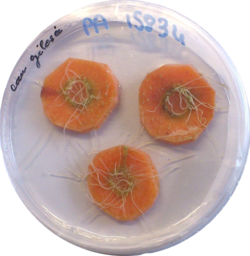Biology:Rhizobium rhizogenes
| Rhizobium rhizogenes | |
|---|---|

| |
| Scientific classification | |
| Domain: | Bacteria |
| Phylum: | Pseudomonadota |
| Class: | Alphaproteobacteria |
| Order: | Hyphomicrobiales |
| Family: | Rhizobiaceae |
| Genus: | Rhizobium |
| Species: | R. rhizogenes
|
| Binomial name | |
| Rhizobium rhizogenes (Riker et al. 1930) Young et al. 2001[1][lower-alpha 1]
| |
| Synonyms | |
| |
Rhizobium rhizogenes (formerly Agrobacterium rhizogenes) is a Gram-negative soil bacterium that produces hairy root disease in dicotyledonous plants. R. rhizogenes induces the formation of proliferative multiple-branched adventitious roots at the site of infection, so-called 'hairy roots'.[3] It also induces galls.[4](p39)
In the rhizosphere, plants may suffer from wounds by soil pathogens or other sources. This leads to the secretion of phenolic compounds like acetosyringone which have chemotactic effects that attract the bacteria. Under such conditions, certain bacterial genes are turned on leading to the transfer of its T-DNA from its root-inducing plasmid (Ri plasmid) into the plant through the wound. After integration and expression, in vitro or under natural conditions, the hairy root phenotype is observed, which typically includes overdevelopment of a root system that is not completely geotropic, and altered (wrinkled) leaf morphology, if leaves are present.[5] R. rhizogenes also propagates as a seed-borne pathogen.[4](p39)
Bacterial genes may be retained within the plant.[6]
The hairy roots are grown in vitro in bioreactors to study their soil interaction with other pathogens like fungi and nematodes. This technique has also led to the commercial production of certain metabolic compounds that the plant is known to secrete, especially in regard to the medicinal plants that are difficult to cultivate in sufficient quantities by other means.[7] The root cultures are also used for genetic engineering.[8][9]
References
- ↑ The Young paper renames on the ground of a lumper view of Rhizobium that subsumes all of Agrobacterium, which also resolves much of the phylogenetic incoherences on the molecular level given 2001 data. GTDB agrees on this assignment of the type strain, and finds that it's still coherent even if Agrobacteirum is not subsumed. However, GTDB makes 4 extra species-level clusters containing genomes likely mislabelled as this species.[2]
- ↑ Young, JM; Kuykendall, LD; Martínez-Romero, E; Kerr, A; Sawada, H (2001). "A revision of Rhizobium Frank 1889, with an emended description of the genus, and the inclusion of all species of Agrobacterium Conn 1942 and Allorhizobium undicola de Lajudie et al. 1998 as new combinations: Rhizobium radiobacter, R. rhizogenes, R. rubi, R. undicola, and R. vitis". International Journal of Systematic and Evolutionary Microbiology 51 (Pt 1): 89–103. doi:10.1099/00207713-51-1-89. PMID 11211278.
- ↑ "GTDB - GCF_000696095.1 (release 214)". https://gtdb.ecogenomic.org/genome?gid=GCF_000696095.1.
- ↑ Chilton, Mary-Dell; Tepfer, David A.; Petit, Annik; David, Chantal; Casse-Delbart, Francine; Tempé, Jacques (1982). "Agrobacterium rhizogenes inserts T-DNA into the genomes of the host plant root cells" (in en). Nature 295 (5848): 432–434. doi:10.1038/295432a0. ISSN 1476-4687. https://www.nature.com/articles/295432a0.
- ↑ 4.0 4.1 (in en) Seed-Borne Diseases of Agricultural Crops: Detection, Diagnosis & Management. Springer Nature Singapore Pte Ltd.. 2020. doi:10.1007/978-981-32-9046-4. ISBN 978-981-32-9046-4.
- ↑ Cardarelli, M.; Mariotti, D.; Pomponi, M.; Spanò, L.; Capone, I.; Costantino, P. (1987). "Agrobacterium rhizogenes T-DNA genes capable of inducing hairy root phenotype" (in en). Molecular and General Genetics MGG 209 (3): 475–480. doi:10.1007/BF00331152. ISSN 1432-1874. https://doi.org/10.1007/BF00331152.
- ↑ Intrieri, Maria Carmela; Buiatti, Marcello (July 2001). "The horizontal transfer of Agrobacterium rhizogenes genes and the evolution of the genus Nicotiana". Molecular Phylogenetics and Evolution 20 (1): 100–110. doi:10.1006/mpev.2001.0927. PMID 11421651.
- ↑ Shanks, Jacqueline V.; Morgan, John (April 1999). "Plant 'hairy root' culture". Current Opinion in Biotechnology 10 (2): 151–155. doi:10.1016/S0958-1669(99)80026-3. PMID 10209145.
- ↑ Otani, Motoyasu; Mii, Masahiro; Handa, Takashi; Kamada, Hiroshi; Shimada, Takiko (1993). "Transformation of sweet potato (Ipomoea batatas (L.) Lam.) plants by Agrobacterium rhizogenes". Plant Science 94 (1): 151–159. doi:10.1016/0168-9452(93)90016-S. ISSN 0168-9452.
- ↑ Van de Velde, Willem; Mergeay, Joachim; Holsters, Marcelle; Goormachtig, Sofie (December 2003). "Agrobacterium rhizogenes-mediated transformation of Sesbania rostrata". Plant Science 165 (6): 1281–1288. doi:10.1016/S0168-9452(03)00339-X. ISSN 0168-9452.
Wikidata ☰ Q138216 entry
 |

